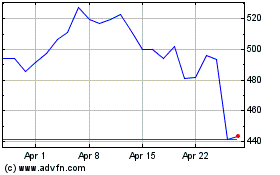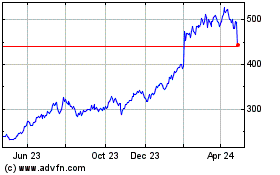YouTube Beats Facebook in Surfacing Brands' Older Videos, Study Says
September 30 2015 - 6:59AM
Dow Jones News
By Nathalie Tadena
In the fierce competition for online video ad dollars, YouTube
has the upper hand when it comes to extending the shelf life of a
marketer's video, according to a new report.
Research from video content advertising firm Visible Measures
says brands enjoy a so-called "ripple" effect when they share a new
video on YouTube that drives views of the brands' older videos, an
effect that does not happen when they share a new video on
Facebook. As a result, videos on YouTube are watched by more people
over an extended period of time, the study claims.
Visible Measures found that 45% of a brand's total views on
YouTube are of new content and the remaining 55% are on previously
uploaded videos to the brand's YouTube channel. In contrast, when
brands upload a new video to Facebook, 95% of the brand's total
views are of the new content rather than existing content.
"YouTube is really search-oriented and Facebook is really
discovery oriented," said Visible Measures Chief Executive Brian
Shin. "Because YouTube has that search capability, it makes it
easier to have a large portfolio of content that can have a longer
shelf life. You can always find stuff on YouTube."
After a user watches a video from a brand, YouTube can recommend
videos from the same marketer or related videos for the user to
watch next. In addition, users are also likely to click on the
YouTube page of a brand if they've enjoyed that brand's video, Mr.
Shin said.
On Facebook, meanwhile, it's more difficult for users to search
for a brand's older video content and users are less likely to go
to a brand's Facebook page after watching a video, Mr. Shin
said.
Facebook for its part has made moves to challenge YouTube in
online video. Facebook in July unveiled a new feature called
"Suggested Videos" that will direct users who view a video in their
news feed to other videos the company thinks they might be
interested in. The initiative will include ads between
professionally produced content from major media companies.
Facebook is valuable for a marketer in the first three days of
releasing a new video, but videos quickly lose consumer engagement
after those initial few days, Visible Measures' data shows. After
the first week of a video's launch, YouTube accounts for 51% of
views. After three months, YouTube accounts for 63% of those views,
Visible Measures said.
"During the first three days of a campaign, Facebook is very
strong for that initial surge (of views) but YouTube quickly
catches up," Mr. Shin said. "You get greater total viewership on
YouTube but on those first few days you want to think about
Facebook as a way to spike your video campaign."
In its report, Visible Measures analyzed 808 video ads
comprising 1.6 billion views from 548 campaigns uploaded in the
first half of the year from brands such as Pepsi, Samsung and Dove.
The campaigns analyzed have both YouTube and Facebook videos with
at least three months of data and more than 50,000 views each.
Write to Nathalie Tadena at nathalie.tadena@wsj.com
Subscribe to WSJ: http://online.wsj.com?mod=djnwires
(END) Dow Jones Newswires
September 30, 2015 06:44 ET (10:44 GMT)
Copyright (c) 2015 Dow Jones & Company, Inc.
Meta Platforms (NASDAQ:META)
Historical Stock Chart
From Aug 2024 to Sep 2024

Meta Platforms (NASDAQ:META)
Historical Stock Chart
From Sep 2023 to Sep 2024
